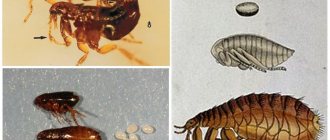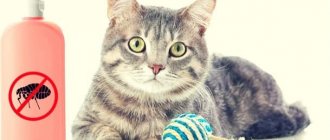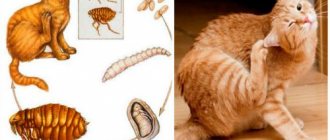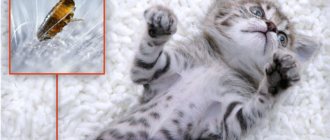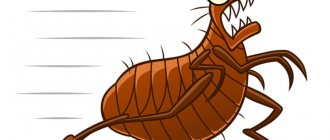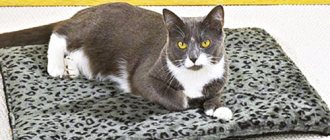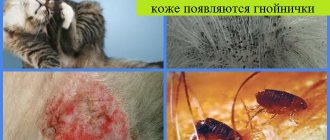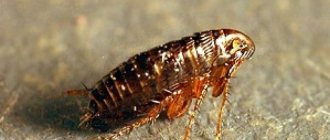Fleas belong to the order of blood-sucking insects. They can be called carriers of pathogens of various diseases that pose a danger to humans and animals.
Wingless insects have a highly specialized oral apparatus necessary for puncturing the skin of the victim and further sucking blood.
Being small in size, parasites are capable of jumping long distances. They often enter houses through basements, entrances, small cracks, and microcracks . Sometimes they can be found even in apartments where there are no pets. If the owner promptly discovered that his pet was suffering from parasites and removed them using special means, flea eggs may still remain in the house, which, under favorable conditions, subsequently become adults capable of leaving offspring.
What do flea larvae look like?
Often, many people, faced with the problem of removing fleas, are interested in what a flea egg looks like? In fact, since both humans and animals can be carriers of parasites, there are some differences that are very difficult to determine without special knowledge.
If we consider the color of a cat or dog flea egg, its shape and size, we can highlight the following features:
- oval shape;
- miniature size (up to 1 mm);
- White color.
The larvae of bloodsuckers that infect animals resemble tiny translucent worms that, after hatching from the egg, remain there until full maturity.
Anabiosis is possible because they do not require blood as food in this state.
Under a microscope, you can see that the entire body of the larva is covered with small hairs; there are no legs. Since the body is translucent and whitish in color, the esophagus with food digesting in it is clearly visible. The larva has a large head for its size with powerful jaws. This feature allows the larva to feed on the toughest food that it comes across.
How do they reproduce?
Despite the fact that fleas reproduce quickly, the process itself is quite complex and requires maintaining certain favorable conditions. The male has testes (2 pieces), ending with genital claws, through which the seed is transmitted to the female. The female has 2 or 4 ovaries, oviducts connecting at the body of the uterus, containing the spermatheca, located at the end of the abdomen in the form of a curved tube.
At the moment of mating, the female climbs onto the male’s back, after which she sucks up the sexually mature organ with the spermatheca. From the testes of a male to the body of a female flea, the seed travels on average about 10–15 minutes. While mating itself can last about a day.
After fertilization, the flea lays eggs in batches (4 to 10 pieces). Since the female needs strength for this, she must be satisfied with food before laying eggs. With normal saturation, a blood-sucking female is capable of laying eggs several times a day.
However, more often females lay one portion per day. Over the entire life cycle of a flea, it is capable of laying 500 eggs, which often infect a pet.
Due to the fact that insects place future offspring on the carrier in advance, subsequently the larvae can easily get enough food and grow quickly. In addition to animal fur, fleas leave clutches in places where they frequent.
The laying process is unique - the female throws eggs from her abdomen over a long distance. It is this method that ensures the vitality of the offspring, since they are at a distance and can eat normally without creating competition for each other.
Treatment and prevention of fleas in cats
The common cat flea (Ctenocephalides felis) is the most common parasite on the skin of cats. Any cat can become infected, except those that live at high altitudes, since fleas do not live at altitudes above 1,500 meters. Indoor cats may have fleas all year round.
Fleas survive by jumping on a host animal, burrowing into its skin and feeding on blood.
In most cases they cause only mild itching, but in severe infestations, especially in kittens or older sick cats, they can cause severe anemia or even death of the cat.
Fleas are also intermediate hosts of helminths. Some cats are hypersensitive to flea saliva. This causes severe itching and a local or general skin reaction.
A flea infestation can be identified by finding fleas on your cat or by seeing black and white flecks in the cat's fur, similar to grains of salt and pepper. These particles are flea feces (“pepper”) and their eggs (“salt”). Feces are formed from digested blood. If you comb them onto damp paper, they turn reddish-brown.
An adult flea is a small, dark brown insect, about 2.5 millimeters in size, that can be seen with the naked eye. Although fleas do not have wings and cannot fly, they have powerful hind legs that can be used to jump long distances. Fleas move quickly in fur and are difficult to catch.
Look for fleas on the cat's back and in the tail and back of the body. To do this, run a fine-toothed comb through the fur. Sometimes fleas are visible in the groin area, where it is warm and there is less fur. Itching is most severe in these areas.
New methods of struggle
New products such as Program, Advantage, and Frontline have virtually replaced the use of solutions, powders, aerosols, and shampoos in the treatment and prevention of fleas. New drugs are more effective and safe than traditional insecticides. They are also easier to apply.
Program (trade name lufenuron) was the first and remains one of the most popular drugs for flea control in cats. Program is a tablet or liquid given once a month with food. The drug is also available in the form of injections, which are administered every six months.
The active ingredient accumulates in the cat's subcutaneous tissue and acts when the flea bites the cat. Program inhibits the growth of eggs and the hatching of fleas. This results in a sustainable reduction in the number of new fleas in the environment.
Its effect is limited to the hard outer shell of the flea; the drug is absolutely harmless to mammals. However, since the drug does not work on adult fleas, it may take 30 to 60 days or more before the adult fleas die of age and you notice a decrease in itching and scratching.
with Program for the treatment to be effective.
Advantage ( imidacloprid) is a topical liquid product that kills fleas on direct contact and is taken once a month.
After application, 98 - 100% of adult fleas die within 12 hours. Therefore, any new fleas that infest the cat must die before they have a chance to lay eggs.
This breaks the fleas' life cycle and ultimately kills all fleas in the environment. Advantage is not absorbed by the cat's body and is therefore non-toxic. Humans do not absorb this chemical when interacting with a medicated cat.
Advantage can be used to treat kittens from 8 weeks of age.
Frontline and Frontline Spray contain the active ingredient fipronil, which kills fleas on contact within 24 to 48 hours. The flea does not have to bite the cat for the drug to work. Frontline is a topical liquid medication in tubes used in the same way as Advantage.
Frontline Plus contains S-methoprene, which kills adult fleas, eggs and larvae. It also treats lice and is used as part of a treatment program for scabies. Frontline Plus is intended for kittens 8 weeks and older.
Revolution (Selamectin), a heartworm preventative, is a topical liquid applied once a month to the skin of your cat's neck between the shoulder blades, just like Advantage . It also treats adult fleas and prevents flea eggs from hatching. Selamectin may also be used to treat ear mites, roundworms and hookworms, and some mites.
Where to look for them
Maturing individuals can be found not only in the fur of animals, but also in various places in the room or apartment where they live. They can be found in corners, crevices, microcracks in floors, behind baseboards, under wallpaper.
Formed bloodsuckers can settle in warm blankets, under the upholstery of upholstered furniture, and inside pillows. Since these insects are blood-sucking, feeding exclusively on blood, their habitat is limited to areas where a person or animal is often found. Thanks to this, they can always find food to survive.
The most likely habitats in which fleas live without an animal in an apartment are:
- sleeping places for pets;
- cracks behind the baseboards, in the floor;
- carpets, upholstered furniture, pile of toys;
- places with high humidity levels (under the bathtub, sink, shower).
Since the female parasite shoots her eggs in different directions when laying eggs, they can colonize any surface. And since the bedding of cats and dogs contains everything necessary for the full development of flea larvae, in addition to the animal’s fur, the flea larva feels comfortable in a sleeping place.
Lifestyle and nutrition of future parasites
Flea larvae are not parasites, since they feed on decaying organic compounds, which make up particles of dead plants, excrement of formed fleas, containing undigested crusts of the victim's blood.
The larvae themselves do not feed on blood, therefore in this state they are harmless to humans and animals.
Maturation of the larvae lasts from 2 to 14 days. After this, the eggs hatch and small parasites continue to develop. The period of final maturation depends on environmental conditions; the more comfortable the larva feels, the faster the process of formation of the individual occurs.
If the ambient temperature is warm enough and there is a high level of humidity, the larvae will develop into an adult within a couple of days. An underdeveloped individual feeds on the feces of mature individuals, dried blood crust, and other layers of organic matter.
As the larva grows, it molts (3 times), after which it pupates like a butterfly. The time the larva remains in the cocoon ranges from several weeks to several months. It depends on the environmental conditions.
If they are unfavorable, the cocoon can remain unchanged for a year until the victim is in close proximity. According to scientists, even in the pupal state, a flea can smell blood. After emerging from the cocoon, the final stage of insect development begins.
Fleas on cats: how to get rid of them
Ctenocephalides felis (cat flea) is mainly found in cats. Simultaneously with cat fleas, cats can be attacked by fleas from dogs and rodents.
Life cycle of a flea
To successfully control fleas, it is important to understand their life cycle. There are four stages in the life cycle of a flea, since the flea is a fully metamorphosed insect.
In fact, only 5% of adult fleas live on a cat, the rest are in the environment in the form of eggs (50%), larvae (35%) and pupae (10%).
Therefore, if you want to get rid of fleas, it is important not only to treat your pet, but also to clean and disinfect the environment (apartment or house and garden).
Adult fleas
Adult fleas emerge from the cocoon, and their emergence is often stimulated by various environmental factors, such as vibration, heat or breathing of the host.
In addition, for different types of fleas, emergence from the cocoon is timed to coincide with a specific season. A flea can emerge from its cocoon within a few seconds of stimulation (for example, vibration from the footsteps of a cat, dog, or person).
The lifespan of adult fleas is about 2 - 3 months. The body of an adult flea reaches a length of about 1.5-4 mm, dark brown or black in color. Adult fleas (both males and females) suck the host's blood.
Adult fleas begin laying eggs within 36 to 48 hours after their first meal of blood. A female flea consumes up to 15 times her body weight in blood per day.
Egg
Just 0.5 mm in length, flea eggs are barely visible to the human eye. The female flea lays about one egg per hour. The eggs are light, whitish, smooth and dry, they easily fall from the animal's fur into the environment (for example, on the floor of your apartment, on beds and sofas, etc.).
Depending on conditions, the egg will hatch into a larva in about 1-10 days. Flea eggs and feces are very often found together. When a cat itches, eggs and droppings fall and spread throughout the apartment. Droppings are what the larva will eat when it hatches.
The eggs and poop together look like salt and pepper.
Environmental conditions such as humidity, lighting and temperature determine how quickly and how many flea larvae will hatch from their eggs. The lower the temperature, the fewer larvae will hatch. Optimal conditions for the appearance of larvae are humidity of about 70% or higher and a temperature of 21 - 32 degrees C.
Flea eggs fall from your cat when she jumps, runs around the house, plays and even sleeps. Eggs are spread throughout the house, but there are especially high concentrations of them in your cat's favorite places (like your bed or her house).
Larvae
Flea larvae are legless, worm-shaped, up to 6 mm long. They avoid light and live deep in carpet fibers, under furniture and rugs, and in cracks. At this stage, they have no legs or eyes, but do have a chewing mouth. The larvae feed on adult flea excrement, food debris and dead skin.
Pupae
This is a transitional stage between larvae and adult fleas. After about 7-18 days, the flea larvae pupate.
It also takes about 7-10 days for the larva to transform into an adult flea in the cocoon; in addition, it may take some time before the flea leaves the cocoon (as you remember, stimulation from the external environment is often needed).
It is at this stage that the flea is most protected and resistant to insecticides, as the larvae are covered in a sticky, silk-like protective outer cocoon covered in debris (such as dust, hair, fur, fabric) and are found in carpet fibers, cracks and other hard-to-reach places where they are almost impossible to detect.
Treating a cat
There are several means of getting rid of fleas on cats, they all vary in price and effectiveness:
- Flea Collars : There are many different types of flea collars sold today. Some contain only insecticides and only kill adult fleas on the cat. Other collars contain IGR, a hormonal insect growth regulator, to kill eggs and larvae. Flea collars, unfortunately, often only kill fleas on the cat's head and neck, but fleas on the rest of the body may survive.
- Shampoo : Flea shampoos contain insecticides that only kill adult fleas.
- Flea comb : Flea combs (should be very fine-toothed) are not very effective, they will only remove 10 - 50% of the fleas on your cat. If you want to use this method, place a small bowl of water with detergent and place the combed out fleas in it. So they will drown and die. If you place a small amount of Vaseline on the teeth of the comb, the fleas will stick to it and this will make your job easier.
- Flea powder : Flea powders kill adult fleas on a cat. However, powders can cause dry fur and irritation of the cat's respiratory tract and mucous membranes.
- Oral medications : For example, a drug such as Program is an oral suspension that is given to the cat once a month. The product is added to the cat's food and absorbed into the blood. When a flea bites a cat who is taking this drug, it ingests the drug's active ingredient (lufenuron), which is transferred to its eggs and prevents them from hatching. Since this product only prevents flea eggs, it is necessary to take the appropriate medication to kill adult fleas. However, you should consult your veterinarian before using multiple medications at the same time. It is also very important to consult a veterinarian when treating pregnant or lactating cats.
- Long-lasting topical treatments : These are effective medications (usually in drops) that are applied to a small area of the back of the cat's neck. These products are very effective in killing adult fleas. The active ingredient varies from product to product. This drug should usually be applied once a month. When using flea medications, it is important to follow the instructions. Cats are very sensitive to chemicals and using multiple flea products can cause your cat to become ill or even die from toxin poisoning. The most effective and popular flea products for use on cats (and dogs) are Advantage, Revolution and Frontline. Revolution also kills worms (except tapeworms), making life a lot easier for pet owners. Advantage also kills flea larvae in the environment.
- Flea Sprays : There are several effective flea sprays on the market. Frontline is one of them. Wear rubber gloves when using the spray on your cat. Avoid contact with eyes and mouth.
Attention! NEVER use flea products intended for other pets on your cat and ALWAYS follow the dosage chart on the package.
We treat the environment
Room treatment
- Aerosols . To treat your home, you can use the services of professionals or buy flea products and apply them yourself. Most of these products are available in aerosol form (for example, “Bomb” or “Raid”). Before treating the room, clear it of people and pets.
- Insect growth regulators disrupt the flea's development cycle. They prevent eggs from hatching, kill larvae and prevent adult fleas from reproducing. These drugs are also most often sold in aerosol form.
- Wash floors, clean carpets, and wash your cat's bedding regularly. Vacuum your home thoroughly, paying special attention to corners, baseboards, under furniture and any other nooks and crannies. Also vacuum furniture, curtains, etc.
Are they dangerous for humans?
Fleas and their larvae can be carriers of various serious diseases that pose a threat to human life:
- Bubonic plague;
- encephalitis;
- anthrax;
- trypanosomiasis;
- tularemia;
- typhus and relapsing fever, etc.
The likelihood of a threat may not be the norm, but a certain percentage remains. This is the most terrible threat to human health and life.
In addition, if you eat food without washing the eggs with your bare hands, you can become infected with various types of worms.
How to remove fleas from a cat
Fleas are small blood-sucking parasites; they multiply very quickly and cause a lot of discomfort to animals. A female flea can lay about three hundred eggs per day, and up to two hundred parasites can live on an adult cat .
If your cat has fleas, you should definitely get rid of them, since the presence of these parasites can cause the cat to develop other more serious diseases.
For example, allergic dermatitis due to fleas is very common. also cause anemia, vomiting, and these parasites also contribute to the appearance of worms .
Sometimes the larvae can get inside the cat, and then a parasitic worm will develop in the cat's intestines.
Symptoms
If your cat is constantly itching, and where her paws cannot reach, she scratches with her teeth (it seems as if she is biting herself), then most likely she has fleas. Of course, sometimes if there are fleas, a cat may not itch very intensely. Another symptom of a cat having fleas can be hair loss.
Also, if you carefully examine a cat, if it has fleas, you will definitely see small black specks on the animal’s body. These black specks are undigested blood by fleas .
If your cat has light fur, then it will be much easier for you to see these grains.
If the cat's fur is dark in color, then try combing the cat with a fine-tooth comb over a sheet of white paper or on a piece of white cloth.
If you find fleas on your cat, treatment should be immediate. Removing fleas from a cat is quite simple, but still remember that they are very tenacious. Therefore, in addition to treating the cat, it is necessary to disinfect the entire house. Especially those places where the cat is most often.
Carpets, sofas, pillows, furniture should be thoroughly vacuumed and sprayed with safe anti-parasitic sprays against fleas (they are sold in veterinary pharmacies, for example, Acrodex, Dermatosol). Bedspreads, linen, and towels must be washed in hot water.
To remove fleas from a cat’s body, you can use various solutions, shampoos, aerosols, emulsions..
But when choosing a product, you must take into account the duration of action of the drug, its toxicity to the animal, side effects, etc. When using any flea product, be sure to read the instructions.
Also, when applying the drug for the first time, it is better to use a slightly smaller dose so as not to cause an allergic reaction in the cat.
And you must remember that you cannot mix different drugs, even if they are completely safe individually.
Flea shampoos are quite effective and easy to use (for example, “Demos”, “Pushok”, “Bolfo”). But when using shampoo, you need to make sure that soapy water and foam do not get into the eyes, nose, ears and mouth of the animal. When using shampoo, it is sometimes necessary to repeat the treatment of the animal after ten to twelve days.
You can also use various flea powders and aerosols, but they must be rubbed especially carefully into the cat's skin and fur . If you choose emulsions, powders or aerosols to remove fleas, then be sure to ensure that the cat licks itself as little as possible. After all, getting such a drug into the stomach can cause poisoning in a cat.
Wormwood can be used as a preventive measure against fleas. This is the safest product for cats, but it does not kill fleas, it only repels them.
Dry wormwood leaves need to be crushed and rubbed into the animal’s fur, and then comb the cat well.
You can also put cotton bags with dried wormwood in those places where the cat prefers to sleep all the time.
And remember, if you notice an allergic reaction in your cat when using any flea medication (redness, even more itching, rapid breathing, etc.), immediately seek help from a veterinarian.
Source: https://topgorod.com/dom/zhivotnye/2291-kak-vyvesti-blokh-u-koshki.html

